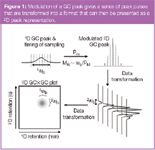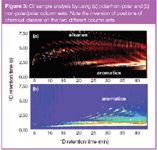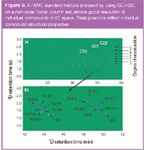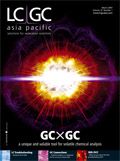Non-Classical Methods in Comprehensive Two-Dimensional Gas Chromatography
LCGC Asia Pacific
It may be somewhat audacious to claim that some methods in GCÃ-GC can be called non-classical - the technique has only been around for about 15 years and one might argue that this is not long enough to establish a suite of classical methods.
It may be somewhat audacious to claim that some methods in GC×GC can be called non-classical — the technique has only been around for about 15 years and one might argue that this is not long enough to establish a suite of classical methods.
However, it is possible to describe a general approach to GC×GC that held a predominant position in the years up to the early 2000s. This incorporated a conventional length 1D (first dimension; ~30 m) column interfaced to a short 2D column, typically 1–1.5 m long. The inner diameter ratio of the two columns (1i.d.:2i.d.) was about 2–3, and the modulation period (PM) was about 4–7 s. This period was selected based on the peak width generated using the first column, such that the modulation ratio (ratio of peak width at base to modulation period) MR was about 3–4.
Figure 1 presents the process used to generate first the modulated peaks, then the data manipulation and finally the 2D plot. Here the relative peak widths on each dimension are represented and the modulation period leads to about seven modulated peaks, which may to some extent oversample the first dimension peak. Each 2D peak is a separate chromatogram on the second column, and data transformation treats this somewhat like a data matrix determined by each of these chromatograms. This is illustrated in Figure 1.

Figure 1
There are a few ways to operate the first column to satisfy these conditions, and a short but very thick film column will also achieve the desired first peak width that allows multiple sampling of the peak. The 2D column is really only concerned with the elution temperature (Te) of the compounds as they pass from 1D to 2D. Te determines the retention factor (k) of the compounds on the 2D column, based on carrier flow-rate (α 1/tM) and film thickness (df), according to distribution constant (K):

Whilst the phase ratio (β) of the two columns is normally not much different, the short length and high carrier flow-rate leads to very low retention times of a few seconds on the 2D columns.
Time, Peak Capacity and Speed
In much of the GC×GC literature, total analysis time has not been a critical concern. Generally, since we achieve such a high peak capacity and very many peaks for GC×GC, most researchers have been interested in displaying the full compositional heterogeneity of a sample, with as many resolved peaks as possible. Indeed, demonstrating the sheer complexity of many samples has been a very attractive goal for researchers. The peak generation potential per minute for GC×GC is perhaps 5–10 times greater than that of a single column analysis. However, with this available separation power, it is possible to sacrifice some of it to produce a much faster analysis, but still with much more separation than a single column.
This contrasts with the usual objective of fast GC — which is to have a faster analysis whilst preserving about the same separation power of the analysis. Thus chromatographers are familiar with the idea of "scaling" a GC run to reduced dimensions that gives faster conditions. Typically we use a shorter, narrower bore column, with faster carrier flow-rate (with hydrogen) and usually a higher temperature programme rate to produce an equivalent separation in a fraction of the time. The Agilent method translation software is a convenient tool to assist in this choice. Conceptually the same scaling can be applied to GC×GC, however, this is not often done. We tend to accept a 45–60 min analysis. Let us walk through the process of making a GC×GC run faster. This can be divided into two distinct considerations:
- Reducing 1D column time: As the total analysis time is largely controlled by the first column time, we have to make the first dimension faster by using shorter columns, higher carrier flows, thinner films and higher temperature programme rates. At the moment, let's just say that the 1D column elution is faster. Clearly this is easy to achieve, although a higher carrier pressure risks exceeding the instrument capability.
- Sampling of the first dimension peaks: The sampling of the first dimension peaks now needs to be considered. The 1D peak width (1wb) will be smaller. We can either sample fewer times (a smaller modulation ratio, MR) or sample faster (smaller modulation period, PM), or both. Small MR means we may undersample the 1D peak and this can lead to losing some of the resolution that has been achieved on the first column. However, the extent to which this compromises a separation still needs to be quantified. Looking at Figure 1, if the first peak is very narrow, then maybe only one modulation pulse will be attained. It is possible that neighbouring peaks that are resolved on the first column, will now be captured into the same modulation event and this can degrade the total resolution.
If we don't reduce the modulation period (i.e., let PM ~ 5 s), then a fast analysis with 1wb = 2 s will lead to a MR ~ 0.4. It is most likely that no GC×GC reports have used such a small MR setting. So the best option is to speed up both the chromatography and the PM. Let PM ~ 2 s, then MR ~ 1. This means we can achieve about 1–2 modulations per peak. Likewise, with PM ~ 1 s, then MR ~ 2 or if peaks are narrower (1 s), MR will be back to ~1. Clearly the speed of all parts of the process is critical and we place considerable demands on the system if we want to choose faster analysis.
Fast GC×GC
The above arguments have ramifications on how fast the mechanical operation of modulation can give such a fast peak sampling. In the most commonly used methods of cryogenic modulation, which derive from the early research of this group from about 1995,1–3 the modulation zone must be cycled through effective cooling, then heating, to efficiently trap then release solute from the modulation interface. Whilst we have recently achieved such a PM of 1 s,4 with a 35 °C min–1 temperature programme rate and 5 min analysis time (for a sample conventionally requiring 30–45 min), faster operation was not considered, since the maximum practical oven programme rate had been reached. However, it was essentially found that the 2D separation space usage was not much different to that in the slower run — we might say that effective method translation was realized. Whilst this shows we can achieve much faster analysis the study was not extended to validation of the approach.
Thermally Labile Natural Products
The analysis of some natural products can be subject to temperature limitations — too high a temperature can lead to compound degradation. We have recently studied analysis of natural pyrethrums. It is imperative that temperature does not exceed about 200 °C. On a conventional column length, elution temperatures of about 250 °C were found. To some, the obvious solution would have been to try HPLC. However, faster GC×GC can achieve the desired elution condition with all the inherent benefits of using a GC method. We chose to use a short 1D column, with on-column injection, and high carrier flow-rates of up to 8 mL min–1 . Elution temperatures below 200 °C were obtained but there are complications with the analysis of natural extracts. There are co-extracted interferences that lead to poor ability to quantify components with FID. However, we reasoned that GC×GC will win back some separation power lost on the first column. But low temperature elution leads to excessively long retentions on the second column. We calculated that k values of about 150 were obtained. This increases the retention time excessively, which would mean we would have to use long PM settings if we did not want wrap-around. So, we chose to use a very short 2D column — of effective length about 15 cm! The result was that we could elute target compounds at low temperature, get adequate resolution of matrix interferences by using the second dimension column and quantify the pyrethrums.5
Low Polarity/Polar or Polar/Low-Polarity Column Sets
A further method "variation" that is becoming much more prevalent is the use of an "inverted phase geometry" column set. Early work essentially used a non-polar/polar set.
This was considered the most "orthogonal"; because the first column mechanism is largely determined by boiling point. This means that overlapping peaks have a similar boiling point. When they pass to the 2D column they will then be separated based on polar interactions. Clearly, this is a very logical approach. Figure 2(a) illustrates this, where compounds 1 and 2 represent two species of similar boiling point, but 2 is more polar than 1; likewise 5 is more polar than 4. Peaks 6–10 represent some sort of homologous series so have incremented boiling points, but similar polarities. As successive homologues elute later, they have reduced retention on 2D (2tR) which is because of higher oven temperature. Now let us switch the column polarities. Figure 2(b) attempts to display the altered column set selectivities for this hypothetical mixture.

Figure 2
As the non-polar compound 1 does not favour retention by the polar 1D column, it now elutes earlier than 2 on the 1D column — 2 is more polar and so is retained greater. Because 1 now enters 2D at a reduced temperature, it is strongly retained in the non-polar phase. We can see, though, that the polar compound is poorly retained by the non-polar phase, and elutes from 2D with low 2 tR. Peaks 4 and 5 can be argued in similar fashion. The moderate polarity suites 6–10 are now retained later than solute 3 but probably still show a reducing 2tR trend across the series. The observation of the trend in retention for compounds 6–10 is linked to what we term "structure" within the GC×GC plot, where related compounds are often located along a readily identifiable retention line within the 2D space. This, along with the "fingerprint" presentation of a total sample composition, are two valuable attributes of GC×GC that are not so readily extracted from single column analysis.
The predictive power of GC×GC has yet to be fully delineated but we note that whilst peak 7 in Figure 2(a) will overlap peak 3 on the 1D column, its separation from 3 is complete on the 2D column, and also its relationship to the series 6–10 is unmistakable. So we now have a completely different — we might say complementary — strategy for the separation of a mixture. Not only a choice of which polar and non-polar column phases, but also in which order they should be placed.
If the polar/non-polar set does not conform to easy definition or identification of its "orthogonality" principle, this does not detract from its use for enhanced separation. The "clean" boiling point/polarity mechanism of the non-polar/polar set most probably now becomes (polar + boiling point) mechanism on the first column with (boiling point + polarity) mechanism on the second for a polar/non-polar set. A more rigorous understanding of the subtleties of such separations needs to be developed. Previous research sought to establish better appreciation of the interplay of polarity on the 2D presentation by systematically altering the polarity of the first dimension though coupling together columns of high and low polarity.6 The relative positions of peaks of different boiling point and polarity will change in response to the net column polarity, which affects elution temperature and alters retention on the 2D column.
Sample Types
The following cases demonstrate the benefits of the inverted phase arrangement:
Petrochemical samples: A non-polar/polar set produces a retention order on the second column of alkanes < cyclic alkanes < olefins < aromatics. The compressed separation of the first two classes, which contain many isomers, gives a reduced resolution for these.
Aromatics are well resolved. By using a polar/non-polar set, the non-polar compounds are now more strongly retained on 2D and have greater resolution. The aromatics are somewhat retained so tend to be less well resolved than before. Figure 3 compares the two column sets for an oil sample. In Figure 3(a), the non-polar compounds are well spread over the upper part of the 2D plot, whereas in Figure 3(b) they are poorly retained and elute almost as an apparent unresolved band at the lower part of the plot.

Figure 3
Coffee volatiles: The headspace of coffee comprises many polar compounds, such as pyrazines and pyridines. Whilst the aroma of coffee is easily recognizable and we might think that it, therefore, comprises compounds in high abundance, we generally have a very complex mixture, with no particular compound dominating. If we use a non-polar 1D column [Figure 4(a)], polar compounds are eluted at relatively low temperature, and so when they are introduced to the polar 2D column, they are strongly retained. This causes significant bunching of many compounds at low retention in the 2D plot.7 Using a polar/non-polar strategy, the polar solutes are better retained so are drawn out along the 1D column and are then not too strongly retained on the 2D column. This gives a much better 2D analysis as shown in Figure 4(b).

Figure 4
Fatty acid methyl esters (FAME): There are now good GC×GC methods for FAME based on non-polar/polar column sets.8,9 The first column choice is not consistent with the usual choice of column for 1D GC of FAME, which tends to be high per cent cyano-propyl siloxane phases. On non-polar phases, there is usually much less separation within a given carbon number group of FAME (with more highly unsaturated FAME eluting earlier and the saturated FAME last amongst the group), compared with that on the cyano-propyl phase (which inverts the elution order and the saturated FAME elutes first).
However, having a polar 2D column gives a very selective separation based on the degree of unsaturation and geometric structure of the FAME. Figure 5 illustrates a reference FAME sample showing that increased degree of unsaturation leads to later 2D elution for this column set. The expanded C18–C20 region provides a demonstration of how molecular structure differences leads to chromatographic "retention structure" differences in the 2D plane. This can be likened to, and treated in much the same way as, a fingerprint, and the pattern should be consistent from one FAME group to another (e.g., for C18 and C20 FAME groups). This promises to be a powerful identification tool as trends and relationships are established for such patterns. A column set with a non-polar 2D column tends to align all the FAME into an almost exponential line within the 2D space, which suggests the retentions are somewhat correlated and little differentiation is achieved.

Figure 5
Summary
GC×GC is rapidly being established as a unique and valuable tool for volatile chemical analysis. Its capabilities extend those of single column GC in a range of unique ways and so new information is provided to the analyst. By challenging GC×GC methods in new application areas, and also exploring different ways to implement GC×GC, there is now a suite of knowledge being accumulated that offers compelling evidence that GC×GC is here to stay.
Further Reading
For nomenclature of GC×GC refer to P. Schoenmakers, P. Marriott and J. Beens, LCGC Eur., 16(6) 1–4 (2003). The following web page also has background information on GC×GC: http://www.rmit.edu.au/applied-sciences/chromatography
Philip Marriott is professor of Separation Science at RMIT University, and deputy director of the Australian Centre for Research on Separation Science (ACROSS). His interests are in high resolution separations, particularly GC, GC×GC, and capillary electrophoresis, with mass spectrometry amongst other detection techniques. Paul Morrison is research technical associate in the ACROSS group at RMIT. He implements high resolution separation strategies and develops strategic instrumental capabilities within ACROSS.
References
1. P.J. Marriott and R.M. Kinghorn, Anal. Chem., 69(13), 2582–2588 (1997).
2. P.J. Marriott and R.M. Kinghorn, J. High Resol. Chromatogr., 19(7), 403–408 (1996).
3. R. Kinghorn, P. Marriott and P. Dawes, J. High Resol. Chromatogr., 23(3), 245–252 (2000).
4. S. Bieri and P.J. Marriott, unpublished results (2006).
5. J. Harynuk and P.J. Marriott, Anal. Chem., 78(6), 2028–2034 (2006).
6. D. Ryan, P. Morrison and P.J. Marriott, J. Chromatogr. A, 1071(1–2), 47–53 (2005).
7. D. Ryan et al., J. Chromatogr. A, 1054(1–2), 57–65 (2004).
8. R.J. Western et al., Lipids, 37(7), 715–724 (2002).
9. L. Mondello et al., J. Chromatogr. A, 1019(1–2), 187–196 (2003).

New Study Reviews Chromatography Methods for Flavonoid Analysis
April 21st 2025Flavonoids are widely used metabolites that carry out various functions in different industries, such as food and cosmetics. Detecting, separating, and quantifying them in fruit species can be a complicated process.
University of Rouen-Normandy Scientists Explore Eco-Friendly Sampling Approach for GC-HRMS
April 17th 2025Root exudates—substances secreted by living plant roots—are challenging to sample, as they are typically extracted using artificial devices and can vary widely in both quantity and composition across plant species.
Sorbonne Researchers Develop Miniaturized GC Detector for VOC Analysis
April 16th 2025A team of scientists from the Paris university developed and optimized MAVERIC, a miniaturized and autonomous gas chromatography (GC) system coupled to a nano-gravimetric detector (NGD) based on a NEMS (nano-electromechanical-system) resonator.

.png&w=3840&q=75)

.png&w=3840&q=75)



.png&w=3840&q=75)



.png&w=3840&q=75)

















